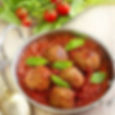The 10 Best Un-Italian Ingredients for Vegan Italian Cooking
- Nadia Fragnito
- Oct 4, 2020
- 4 min read
Updated: Jun 19, 2022
Italian cooks and food critics will tell you - adamantly - that Italian cuisine is best at its simplest. Minimal fuss and fewer ingredients the better. Whilst I wholeheartedly lean into this unfussy approach to cooking, things are a little different when trying to recreate classic meat and dairy dishes. One needs to get a little more creative and utilise some unexpected ingredients from other cultural cuisines.

But is this incredibly un-Italian? Are we committing culinary sacrilege? What is this cooking quackery?
What we really know is that Italian cooking is no stranger to diversification and improvisation. Cucina povera is a kitchen rebellion at its best. Traditionally, breadcrumbs have been fried up into crunchy morsels to substitute parmesan cheese, when cheese was far too luxurious for poorer families in the south. Fresh pasta was made senza uova. My dad told me stories of how his family used to mix snow with wine to create a peasant’s sorbet. And the Italians most favourite waste not want not trickery is to re-fashion stale bread into flavourful soups, salads, polpette di pane and into the heavenly stuffing of baked or fried vegetables.
So in honour of this improvisational Italian style, here is a list of unconventional ingredients that will have your Italian dishes taste more like the luxurious classic dishes of your sensory memory. These ingredients became my best cooking buddies when forging my cookbook Discovering Vegan Italian: classic dishes made vegan. I hope they can be yours too.
When whipping up vegan Italian dishes, be sure to stock your pantry and fridge with the following:
1. TOFU
One of several Japanese ingredients I’m going to suggest for your vegan Italian toolkit. Grab extra firm tofu. This is the perfect texture for processing into ricotta cheese and slicing into pancetta pieces, soaking up a marinade and frying into juicy morsels for your spaghetti carbonara.

2. LIQUID SMOKE
A condiment that actually smells and tastes like smoke, and when added to your dish, will take on a meaty flavour. Dribble liquid smoke into your walnut mince for polpette or for ragu. Add to a marinade for tofu pancetta and carpaccio.

3. SOY SAUCE
Soy sauce creates an ideal meat marinade, transforming white tofu slices into salty and meat-brown pancetta.
Try it in Spaghetti Carbonara
4. KALA NAMAK
This salt spice is usually at home in an Indian grocery store, but in an Italian kitchen it replicates the smell and flavour of eggs. Thanks to its sulfuric qualities, kala namak (aka black salt) is surprisingly, wonderfully egg-like when sprinkled into your chickpea frittata, egg sauce for carbonara or egg yolk desserts like zabaione and tiramisu.

5. SEA VEGETABLES AND VEGAN FISH SAUCE
The reality is, we don’t need to kill the sea creature in order to enjoy the taste of the sea. Sea vegetables such as wakame, kelp and nori are infused with the ocean, so when added to dishes that ordinarily feature calamari or fish, the flavour is reminiscent of seafood, senza animale. If you can find vegan fish sauce at an Asian grocery, there is no stopping your creativity in the vegan Italian kitchen. Add to marinated King Oyster mushrooms for the coolest, plant-based calamari entree or pasta seafood dish.

6. TURMERIC
Take a light touch with this rather pungent spice. It is not included in your toolkit for its flavour but instead to mimic the colour of egg in a plethora of dishes, such as the egg sauce in carbonara and pastry cream commonly made with egg yolks.

7. WALNUTS
Well actually, walnuts (noci ) do feature quite prominently in Italian cooking. But not as a meat substitute. Rich and dark, walnuts are the ideal nut to enjoy as a chunky meat ragu or mince. Add a few seasonings and you will have an impressive base for meatballs and mince for a lasagne.

8. SOY MILK
Soy milk may seem rather obvious, but when I created the index for my cookbook, soy milk was the most used ingredient. I used it in practically every recipe, because it is the ideal substitute for dairy milk. Grab yourself a full fat soy milk, none of this ‘light’ stuff - you need the fat normally found in Italian dairy dishes. Soy milk is the base of ‘egg yolk’ custards, creamy sauces, cheeses, cakes and practically every dessert. Remember my advice, use the fattiest soy milk.

9. AQUAFABA
The brine found in a can of chickpeas has miraculously been revealed as an ugly duckling in disguise. Aquafaba translates to bean water. Instead of pouring this down the sink as waste, take a heavy duty electric beater to the brine and whip it into egg whites. Vegan rebellion at its best. And now it's your favourite friend when you need to create airy tiramisu custard and almond meal biscotti.

10. NUTRITIONAL YEAST FLAKES
This unique condiment is best used as a flavouring to replace parmesan cheese. On its own, it doesn’t actually taste like cheese, but more a umami savoury flavour. When added to a cream sauce, provolone cheese, or as a base for cashew parmesan cheese, you have just the right hint of cheesiness.

Break the rules. Play, experiment, taste. In order to be Italian in your vegan kitchen, sometimes you gotta be a little un-Italian too.

